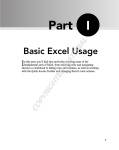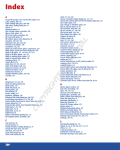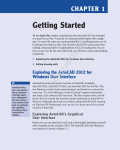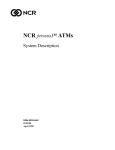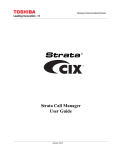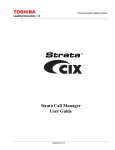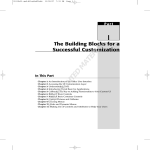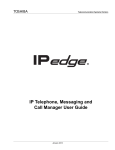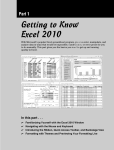Download Wiley Excel 2010 Just the Steps For Dummies
Transcript
RI Chapter TE E D MA xcel is like a giant accountant ledger sheet composed of a grid made up of columns and rows. At each row and column intersection is a cell. A single worksheet contains 16,374 columns across the top (stretching from column A to column XFD) and 1,048,576 rows down the side. That’s over 17 billion cells in a single worksheet. A cell address is the description of the intersection of a column and a row, such as D23 (in this example, D is the column name and 23 is the row). GH TE The Excel interface provides you with the right tools at the right time. In most Windows programs, you see menus and toolbars to select your options from. Instead of the traditional look, Excel provides icon- and button-laden tabs on the Ribbon containing most Excel features. PY In this chapter, you discover how to RI Throughout the course of this book, you discover methods to use Excel as a spreadsheet, of course; but you also discover how to use it as a database, a calculator, a planner, and even a graphic illustrator. I start with the basics and work into the more advanced Excel actions. Open and close the Excel program. Work in the new Backstage View. CO ➟ ➟ ➟ ➟ ➟ ➟ ➟ ➟ ➟ AL Working with Excel Files Select commands with your keyboard. Change information on your status bar. Create, open, and save Excel workbooks. Convert earlier files to Excel 2010. Delete and rename workbook files. Use workbook properties to better manage your files. Get ready to. . . 1 ➟ Open and Explore Excel............................... 6 ➟ Explore Backstage View ............................... 7 ➟ Close Excel .................................................. 7 ➟ Select Commands with the Keyboard............ 8 ➟ Change Status Bar Indicators ....................... 8 ➟ Create a New Excel File ............................... 9 ➟ Save a Workbook........................................ 9 ➟ Save a Workbook in a Different Format .......10 ➟ Open an Existing Excel File ........................ 10 ➟ Convert a Prior Version File to Excel 2010.......11 ➟ Delete a File ............................................. 11 ➟ Rename a File ........................................... 12 ➟ Specify Workbook Properties ..................... 12 Chapter 1: Working with Excel Files Open and Explore Excel 1. Choose Start➪All Programs➪Microsoft Office➪Microsoft Excel 2010. The Microsoft Excel program begins with a new, blank workbook displayed ready for you to enter data. Figure 1-1 illustrates some of the common workbook components. 2. Click any tabs, or task-oriented portions, of the Ribbon. The first tab, which is displayed in a color different from the other tabs, is called File. Clicking File displays the Excel Backstage View, which you find more about in the next section. The remainder of the tabs is broken down into subsections, or groups. For instance, the Home tab includes the Clipboard, Font, Alignment, Number, Styles, Cells, and Editing groups. Point your mouse over any button, and a description of the tab’s features appear. 3. Click the Insert tab. The Ribbon changes to reflect options per- taining to Tables, Illustrations, Charts, Links, and Text groups. Figure 1-1 Additional tabs appear when they’re useful for the current task. 4. On the Home tab, click the down arrow next to the Format as Table button. A gallery of table styles appears. (Click the arrow again to close the gallery.) 5. On the Home tab, click the dialog box launcher on the bottom- right of the Font group to open a related dialog box (see Figure 1-2). In this example, the Format Cells dialog box opens. Click the Cancel button to close a dialog box without making any changes. 6. Pause your mouse over any of the three icons above File. By default, the Quick Access toolbar functions include Save, Undo, and Redo. 6 Figure 1-2 Close Excel Explore Backstage View 1. Click File. Excel Backstage View opens with three columns. The left column represents actions you can select. 2. Choose Print from the left column. The middle column changes to show tasks relative to printing (see Figure 1-3). See Chapter 13 for more information about printing. 3. Choose Recent in the left column. A list of workbooks you worked on recently displays. You can click any workbook to open it. See the steps in the section, “Open an Existing Excel File,” later in this chapter. 4. Choose Info in the left column. The middle column represents a second level of tasks related to your current workbook, and the right column displays the workbook properties. See the section, “Specify Workbook Properties,” later in this chapter. 5. Click File again. Backstage View closes, and you return to Figure 1-3 your current workbook. Close Excel 1. Click File, and from Backstage View that appears, choose Exit, as shown in Figure 1-4. Alternatively, click the Close button (X) in the upper-right corner. 2. Click Save or Don’t Save if prompted to save your workbook. (See the section, “Save a Workbook,” later in this chapter.) (Optional) Choose File➪Close. The current workbook closes, but the Excel program remains open. Figure 1-4 7 Chapter 1: Working with Excel Files Select Commands with the Keyboard 4. Click anywhere in the Excel workbook to close the Customize Status Bar menu. 1. Click any cell on the worksheet. 2. Press the Alt key on the keyboard. Shortcut letters appear on the Ribbon, and numbers appear on the Quick Access toolbar (see Figure 1-5). Numbers control commands on the Quick Access toolbar. 3. Press a letter on your keyboard to select a tab on the Ribbon; for example, press the P key to display the Page Layout tab. Shortcut letters then appear for each command on that tab. Figure 1-5 4. Press a letter on your keyboard to select a command. Excel displays options for the command you selected. 5. Press a letter or use the arrow keys and then press Enter on the keyboard to select an option. Excel performs the command you selected, applying the option you chose. Press the Esc key to step the KeyTips back one step. Change Status Bar Indicators 1. Right-click anywhere along the status bar at the bottom of the window. Excel opens the Customize Status Bar menu. 2. Active features have a check mark next to them and inactive features do not. To activate an inactive feature, click it. This automatically adds a check mark. In Figure 1-6, the Caps Lock feature is off. 3. To deactivate any active feature, click it to remove the check mark. 8 Figure 1-6 Save a Workbook Create a New Excel File 1. Choose File➪New. Backstage View shows templates you can choose from in the middle column (see Figure 1-7). 2. Select the Blank Workbook option and then click the Create button. Excel creates a blank workbook based on the default template. See Chapter 10 for more information about Excel templates. Press Ctrl+N to create a new workbook without opening the New Workbook dialog box. Figure 1-7 Save a Workbook 1. Choose File➪Save or click the Save button on the Quick Access toolbar. The Save As dialog box appears, as shown in Figure 1-8. The Save As dialog box only appears the first time you save a file. 2. By default, Excel saves your files in the Libraries➪Documents folder. If you want to save your file in a different folder, select that folder from the folder pane. 3. In the File Name text box, type a descriptive name for the file. Filenames can’t contain an asterisk (*), a slash (/), a backslash (\), or a question mark (?) character. 4. Click the Save button. Excel saves the workbook in the loca- tion with the name you specified in Step 3. Figure 1-8 9 Chapter 1: Working with Excel Files Save a Workbook in a Different Format 1. Click File and, from Backstage View that appears, choose Save As. The Save As dialog box appears. 2. In the File Name text box, type a descriptive name for the file. 3. Click the drop-down arrow on the Save as Type drop-down list to display a list of file formats. 4. Choose 1 of the 27 different file formats (see Figure 1-9). Files saved in Excel 2010 or Excel 2007 format have an .xlsx extension, whereas files created in earlier versions of Excel have an .xls extension. 5. Click the Save button. Depending on the format you choose, Excel may prompt you for additional information. Open an Existing Excel File Figure 1-9 1. Click File and from Backstage View that appears, choose Open. The Open dialog box, as shown in Figure 1-10, appears. From File, click Recent and then Excel displays recently used files in the middle column of Backstage View. Click any listed filename to quickly open it. 2. If necessary, select the appropriate folder from the folder pane and then select the file you want to open. Open the file type drop-down list to display files saved in other formats. 3. Click the Open button. The workbook appears in the Excel workspace, ready for you to edit. If the file you open was created in Excel 2003 or an earlier version of Excel, Compatibility Mode appears on the title bar next to the document name. (See the following section for more information.) 10 Figure 1-10 Delete a File Convert a Prior Version File to Excel 2010 1. Open a workbook created in an earlier version of Excel; the Figure 1-11 title bar indicates that Excel opened the document in Compatibility Mode. 2. Click File and from Backstage View, choose Convert. Excel displays a message indicating you’re about to convert the current workbook (see Figure 1-11). 3. Click OK and then another conversion message appears. 4. Click Yes and then Excel saves the file in the new format. Excel replaces the older version of the workbook, using the same name you used for the older version of the document. If the older version was an Excel 97–2003 or earlier document, Excel 2010 changes the extension to .xlsx. Compatibility Mode disappears from the Excel title bar. Figure 1-12 Delete a File 1. Open Excel but do not open the file you want to delete. Click File and choose Open or Save As. Either the Open or Save As dialog box appears. 2. If necessary, in the folder pane, navigate to the folder con- taining the file you want to delete. 3. Select the unwanted file and choose Organize➪Delete (see Figure 1-12). A confirmation message appears. 4. Click the Yes button, and Excel deletes the file. 5. Click the Cancel button to close the Open or Save As dialog box. 11 Chapter 1: Working with Excel Files Rename a File 1. Open Excel but don’t open the file you want to rename. Choose File➪Open or Save As. The Open or Save As dialog box appears. 2. If necessary, in the folder pane, navigate to the folder con- taining the file you want to rename. 3. Select the file you want to rename and choose Organize➪Rename. The original filename becomes highlighted. (See Figure 1-13.) 4. Type the new filename. Filenames can’t contain an asterisk (*), slash (/), backslash (\), or question mark (?) character. 5. Press Enter when you’re finished typing. Figure 1-13 6. Click the Cancel button to close the Open or Save As dialog box. Specify Workbook Properties 1. From an open workbook, click File and from the Info panel on the right, choose Properties. A list of options appears. 2. Choose Show Document Panel. The workbook reappears, and the Document Information panel appears. 3. Enter identifying information such as the author’s name, sub- ject, or a list of keywords. See Figure 1-14. Figure 1-14 Excel automatically adds statistical information, such as the workbook’s original creation date, the last time the workbook was printed or modified, and the workbook size. 4. Click the Close (X) button to close the Document Information panel. 12








